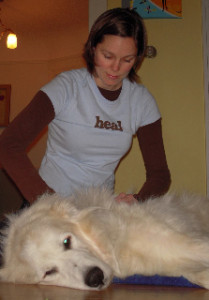Canine massage?! That’s the response most people have when they hear you talk about massaging your dog. However, just like with people, massaging your dog can relieve pain and stress, calm nerves, and strengthen the bond you have with your dog.
Rubi Sullivan, CSAMP (certified small animal massage practitioner) explains that “massage is a gentle and non-invasive therapy that is a great way to maintain your dog’s health and well-being, as well as regular veterinary visits.”
What are the Benefits?
Massage is a benefit to any age of dog, regardless of whether they are a family pet, star athlete, or somewhere in between. Sullivan lists several ways that massage can help any dog:
- Reduces anxiety
- Shortens healing time of strained muscles and sprained ligaments
- Aids in digestion
- Fosters a feeling of well-being
- Reduces pain and swelling (including intervertebral, joint and muscle)
- Decreases blood pressure
- Strengthens the immune system
- Reduces formation of excessive scar tissue (less scar tissue build up means better mobility)
- Reduces muscle spasms
- Helps relieve muscle tension and stiffness
- Provides greater joint flexibility and increases range of motion
- Improves proprioception (the outside information feedback mechanism in the animal’s body that helps with movement and balance)
- Stimulates liver and kidney functions
- Improves circulation of blood and movement of lymphatic fluids
- Promotes deeper and easier breathing
- Enhances the health and nourishment of the skin and coat

Should my Dog Get a Massage?
Based on the above benefits, it’s clear any dog will be happy to have a massage. However, there are a few cases where massage can be particularly helpful.
Reducing stiffness and fatigue after exercise by increasing circulation and flushing waste products form the muscle tissue.
Massage can be great for both before and after exercise. Invigorating massage (quick strokes) can be great for dogs that are about to compete in agility competitions or for older dogs that are stiff and about to go out for a walk in the neighborhood.
“If the massage strokes are too invigorating for older dogs,” Sullivan explains, “you can always slow down your stroke. It’s important to always watch for feedback from your dog, they can tell you so much when you watch and listen for changes. Slow, gentle strokes can be a very nice way to compliment an end to exercise.”
